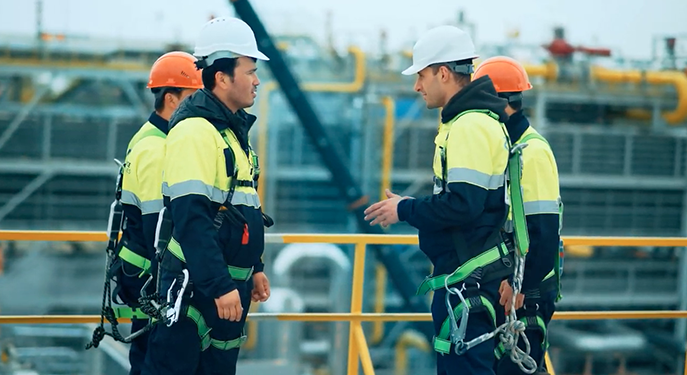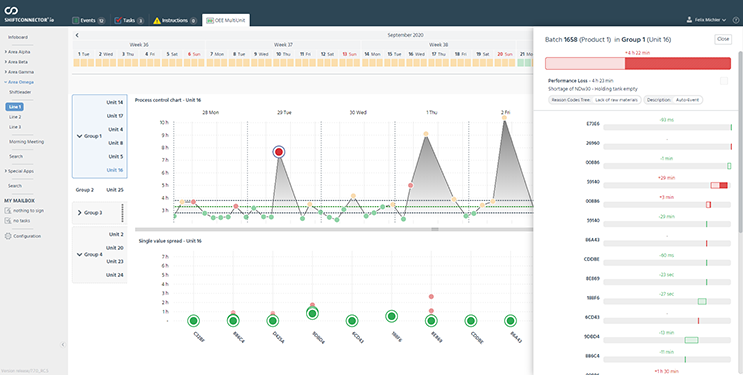
PPM: How you can maximize the contributions of people in your plant
By By Andreas Eschbach and Dr. Andy Brazier
Features eschbach Plant Process Management PPM process technicians safety PPM combines the natural attributes of people with technology to assure optimal communication, safety, and production.
PPM combines the natural attributes of people with technology to assure optimal communication, safety, and production. Technology and automation continue to up-end the boundaries between man and machine. While machines are now more involved in manufacturing processes via artificial Intelligence and cloud computing, people still run process manufacturing plants and are accountable.
The ideal environment is one where Plant Process Management (PPM) combines the natural attributes of people with technology to assure optimal communication, safety, and production – in a symbiotic relationship. PPM describes applications that help manufacturing organizations manage, monitor, and optimize work activities and production assets with a central digital repository of information.
This article will cover the importance of the process technician and the role of technology to support human factors and machine collaboration.
Acknowledging Process Technicians
For many chemical and pharmaceutical companies, process technicians are key operators working in shifts for either a batch process or continuous manufacturing environment. They operate equipment, monitor the machinery, and document results in strict adherence to protocols. The processes may involve a chemical reaction or blending of ingredients (liquid, powder, or gas) continuously or in a batch before they become finished products.
Process technicians may work as process operators, chemical process technicians, bioprocess technicians, cleanroom operators, or system operators. This involves the production of chemicals, drug substances, or active biological substances – while following Good Manufacturing Practices (GMP) and ensuring compliance with the pharmaceutical or chemical company’s Standard Operating Procedures (SOPs) and meeting many regulatory guidelines.
Nothing Works Without the Team
Because technical operations run as a team, all need a solid understanding of procedures, techniques, tools, substances, and equipment. Workflow needs to be prioritized and team members should be contributing to the team’s success by sharing their previously acquired knowledge using an automated approach with PPM. This is extremely important because while everyone is accountable for their own results, what happens during one shift can substantially impact the team members coming to join the next shift.
Another area not to be overlooked from one shift to another involves maintaining area housekeeping standards and hygiene specifications by using a variety of sanitizing aids. For the team lead, they may also have to support the implementation of new technology for process execution and/or analysis. They must ensure and maintain all current training statuses on all applicable SOPs as well as execute SOPs for unit or equipment operations.
Highlighting the Human Factor
While machines are very good at capturing and storing data, humans can remember perceptions, images, and feelings. Thus, only people can draw on human attributes to create a better understanding from what been experienced or memorized from past experiences.
Technology can only do what we’ve asked it to do while people are able to create new processes or situations when the unexpected arises.
As the price of storing data has declined and cloud-based systems have emerged, more and more information is available for data mining, but in general, the process manufacturing industry has not invested the millions of dollars necessary to ensure that the data can be utilized effectively.
Adapting the Behaviour of a Shift Team to a PPM Approach
When it comes to the implementation of a PPM platform with use cases such as shift handover, incident reporting, or routine inspections, it is important to strive for a wide acceptance of the lower-level plant worker.
It is crucial for the success of a digitization initiative to make allies of shift workers. With plants running 24/7, there is generally less management around during nights and weekends. With self-service configuration those users can change and adapt their set-up according to new regulatory requirements, equipment, or process updates which keeps the ownership of the application in the plant.
Adapting the behaviour of a shift team with people who have worked in the same plant for decades is an endeavor that needs to be well-prepared.
Today’s systems are intuitive to learn, which means that many operators can embrace new procedures with relatively little training. However, appointing an early adopter in the concept phase and providing training and hand-holding procedures helps to bring along the people who may be uncomfortable or skeptical of digital technology. Often these people can be long-time contributors who bring decades of experience, and their perspectives can be very impactful in creating an important knowledge base. This is all good preparation for the great “crew change” — the year when several people may retire.
In global rollouts there needs to be strong local teams, each with management support as well. Today, with a capable PPM solution and an experienced consulting team, rollouts can even be done remotely. For example, one company that benefited from PPM, executed a global rollout across 10 countries, 6 time zones, and 40 different plants in less than 6 months.
Designing for People – Invest in Human Factors
In a 12-hour shift, how much data is retained or forgotten during that shift? On a good day, a high proportion of data generated may be retained. On a stressful shift, it may be only half. Transfer of data to the next team will be directly affected by this, especially when errors and omissions of communication are factored in.
Relying on process technicians to remember all information and to communicate it reliably either verbally or via written documents will always be problematic. Inaccurate communication can result in many different problems, including safety issues, especially considering they can be involved at all stages of a manufacturing process. Their role requires that they follow strict internal protocols and SOPs as well as following cGMP. There is a tremendous amount of responsibility given to individuals within these roles. Any deviation from these practices or any mistake made could have serious repercussions, resulting in potentially unsafe defective products or expensive destruction of batches.
A process technician will typically be responsible for a single specific step in the manufacturing process as it is their job to know this process in great detail and identifying when the process deviates from the norm. They are enlisted to take action to correct a deviation or involve senior members of staff, usually a process engineer, if and when they aren’t able to correct the problem. Additionally, equipment within their process must be kept in good working order. This involves regular inspection, cleaning, servicing, and maintenance. Considering this tremendous responsibility, it makes sense to use an automated system to maintain accurate and clear documentation to prove — and to show upon request by auditors – that these processes are being carried out in accordance with both internal and external regulations.
Automating the information shared between teams ensures continuity and mitigates risk. It serves as a running protocol of relevant events and conditions that together describe the state of manufacturing processes within a specific timeframe. To align all these sources, automation can help by providing an accurate, formal digital record of the plant operations and can be used by any team member who needs it.
Automation can Alleviate Risks in Shift Handovers
Poor communications at shift handovers have been identified as one of the causes of two particularly notable plant disasters. For example, the Piper Alpha explosion, which occurred on a North Sea oil rig in 1988, resulted in the deaths of 167 and impacted, at the time, 10 percent of North Sea oil and gas production. There appeared to be two communication failures that occurred around the time of handover between day and night shifts. First, maintenance personnel did not communicate effectively that the relief valve had not been returned as originally planned. They returned a ‘suspended’ permit to work to the permit office but did not talk to anyone about the work or inform about the delay. Secondly, communication at the operations shift handover meant that the night shift knew that condensate Pump A had been isolated in preparation for its overhaul, but the overhaul had not started. However, the removal of the relief valve was not communicated and so the night shift was not aware that it was or could have been missing. The conclusion was that a shift handover had taken place as some information about plant status had been communicated (i.e., pump being isolated); but it had not been effective because other information (i.e., relief valve being removed) was not. This meant that the night shift operators made decisions when facing a potentially serious loss of production based on an inaccurate knowledge of plant status.
In another example, the BP Texas City refinery explosion, which occurred in 2005, resulted in the deaths of 15 workers, 180 injured and severely damaged the refinery. In this case the night shift operator left early, and subsequent shift handovers were minimal. Records in the shift log were brief and ambiguous and thus mis-interpreted by the incoming shift. A root cause of these failures was that BP did not have a shift turnover communication requirement for its operations staff. Also, the investigation found that key messages were often not written down but passed verbally over the phone and radio. This resulted in the board and outside operators interpreting a message regarding routing of raffinate differently. The Board operator closed a control valve. The outside operator manually opened that valve, which ultimately caused the explosion.
While these examples are only two of the most notable communications failures, many other crises that have had less significant outcomes, have occurred due to incorrect or missing information that could have been avoided with a PPM platform.
Success stories have also been documented by those who have implemented digital transformation programs. Polymer manufacturer, Covestro, undertook a digital transition in all its plants after realizing that a combination of Excel sheets, phone calls, and logs books could be easily replaced with a web-based shift handover system that could be accessed universally. An interface with the company’s SAP platform empowered employees to retrieve information from a central location and greatly increase quality, efficiency and, importantly, improve plant safety in more than 30 global locations.
The technology delivered via a PPM platform plays an important role in alleviating miscommunication, thus averting possible critical failures and better yet, empowering people to assure smooth, efficient, and safe plant operations.
Summary – Embrace Technology and Support Human Factors
Technology won’t replace people. The aim should be to use technology to enable people to use their natural capabilities and increase their performance. Successful manufacturing enterprises will embrace an approach that elevates the attributes of both people and technology to help the human-machine network work together in a more collaborative way. This will ensure more transparency, reliability, and visibility across all plant functions to help teams better communicate and optimize outcomes.
Andreas Eschbach is CEO, eschbach and Dr. Andy Brazier is Industry Consultant for Risk and Process Safety.
Print this page
